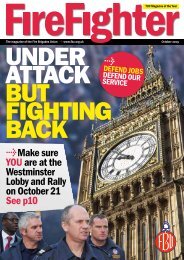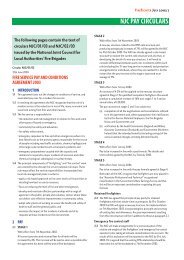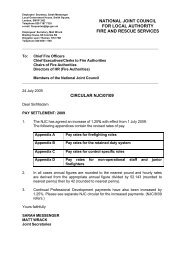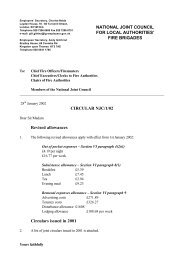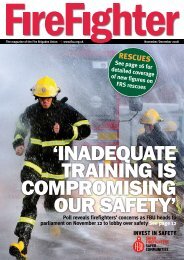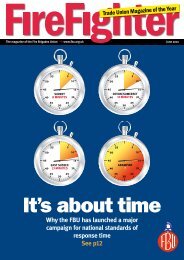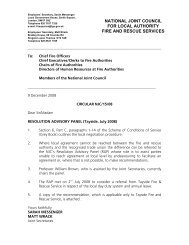Firefighter July 2010 - Fbu.me.uk
Firefighter July 2010 - Fbu.me.uk
Firefighter July 2010 - Fbu.me.uk
- No tags were found...
You also want an ePaper? Increase the reach of your titles
YUMPU automatically turns print PDFs into web optimized ePapers that Google loves.
YOUR WELFARE HEALTHSo<strong>me</strong> don’t like it hotWorkplace temperatureMany thousands of workers inindoor workplaces like offices,shops and factories face hightemperatures at work all yearround, but especially so in thesum<strong>me</strong>r. Fire stations and control roomsare no exception. At ti<strong>me</strong>s, working insideduring the hot weather is not healthy.If people get too hot, they risk dizziness,fainting or heat cramps. In very hot conditionsthe body’s blood temperature rises. Ifthe blood temperature rises above 39°C, thereis a risk of heat stroke or collapse. Deliriumor confusion can occur above 41°C. Bloodtemperatures at this level can prove fatal andeven if a worker does recover, they may havesuffered irreparable organ damage.Even at lower temperatures, heat leads toa loss of concentration and increased tiredness,which <strong>me</strong>ans that workers are morelikely to put themselves or others at risk.How we are affected by heat is also influencedby humidity and the physical nature ofthe work. Other factors influencing how heatwill affect so<strong>me</strong>body is their degree of fitness,age and <strong>me</strong>tabolism.SHUTTERSTOCKThe law at workThe Workplace (Health, Safety and Welfare)THE UNION VIEWUnions want a maximum temperaturelimit to serve as a point whereemployers must take action. The TUCis calling for a maximum workingtemperature of 30°C, or 27°C forthose doing strenuous work. A“trigger temperature” would forewarnemployers to prevent discomfort byintroducing <strong>me</strong>asures, such as buildingredesign, insulation and ventilationsystems. Workers, whose exposureto heat cannot be reduced, should beprovided with adequate breaks andoffered job rotation.Regulations 1992 state that: “Duringworking hours, the temperature in all workplacesinside buildings shall be reasonable.”The regulations also require employers toprovide “a sufficient number of thermo<strong>me</strong>ters”to enable workers to determine thetemperature.However the law treats cold temperaturesdifferently from hot temperatures.During cold weather, employers are legallyobliged to act when temperatures dropbelow minimum standards. An approvedcode of practice (ACOP) accompanying theregulations lays down a minimum workingtemperature of 16ºC. If the work involvessevere physical effort, 13ºC is acceptable.However, when it co<strong>me</strong>s to high temperaturesin indoor workplaces, there is no legalmaximum temperature. The ACOP <strong>me</strong>relysays that “all reasonable steps should betaken to achieve a reasonably comfortabletemperature”, such as providing air-coolingplant, shading windows and siting workstationsaway from radiant heat. But itsuggests no maximum limit.So<strong>me</strong> professional organisations doindicate the range of acceptable workingtemperatures for human beings. The WorldHealth Organisation states that, in temperateclimates such as Britain, the optimum indoortemperature is between 18ºC and 24ºC. TheChartered Institute of Building ServicesEngineers, whose <strong>me</strong>mbers design buildings,recom<strong>me</strong>nds that temperatures shouldnot exceed 27ºC.HSE guidanceThe Health and Safety Executive (HSE)booklet, Thermal comfort in the workplace:guidance for employers, suggests a rangeof 13ºC to 30ºC, but it emphasises that thismay not ensure thermal comfort whenother factors are taken into account. Thesefactors include ventilation, humidity, thework involved and the person undertakingthe work.Last year the HSE board refused to recom<strong>me</strong>nda<strong>me</strong>nding the law to impose an upperworkplace temperature limit despite strongtrade union argu<strong>me</strong>nts in favour of a limit.HSE commissioned research thatconcluded that “on balance, the workplacetemperature issue is not one thatjustifies active regulatory intervention”.Instead the study called for “improved jointworking between all parties to the issue –govern<strong>me</strong>nt, trade unions and employerrepresentatives”.Earlier this year unions circulated an HSEquestionnaire to help it gather evidence asto whether high temperatures at work are aproblem in particular sectors or across theboard. It hopes that the responses will alsoassist in identifying practical and effectivesteps that can be taken to tackle the issue.> > The union case for a legally enforceablemaximum temperature is set out at www.tuc.org.<strong>uk</strong>/extras/maxtemp2009.pdf18 FireFighter FBU Month FREE 2006 CONFIDENTIAL STRESS & SUPPORT HELPLINE 0800 783 4778






